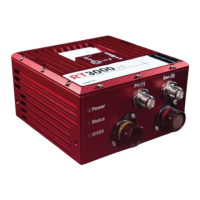Oxford Technical Solutions Ltd Page 19 of 110
Notes on specifications
The performance specifications are listed for operation of the system under the following conditions:
• A short warm-up period (~3 minutes) during which motion inputs will be used by the navigation system to
estimate sensor error characteristics.
• Open-sky environment, free from cover by trees, bridges, buildings, or other obstructions. The vehicle must
have remained in open sky for at least five minutes for full accuracy.
• The vehicle must exhibit some motion behaviour. Acceleration of the unit in different directions is required
so the Kalman filter can estimate any errors in the sensors. Without this estimation, some of the
specifications degrade.
• The distance from the INS measurement point to the primary GNSS antenna must be known by the system
to a precision of five millimetres or better. The vibration of the system relative to the vehicle cannot allow
this to change by more than five millimetres. The system will estimate this value itself in dynamic
conditions.
• For dual antenna systems, the system must know the relative orientation of the two antennas to 0.05° or
better. The system will estimate this value itself under dynamic conditions.
• For single antenna systems, the heading accuracy is only achieved under dynamic conditions. Under
benign conditions, such as motorway driving, the performance will degrade. The performance is undefined
when stationary for prolonged periods of time.
To achieve full accuracy in real time, the RT products will require appropriate differential corrections where
applicable, either from a base station or with a TerraStar licence. Alternatively, a RINEX file can be downloaded
post-mission and used to post-process the data to full accuracy.
For the TerraStar service, at least 30 minutes of open-sky condition (5 minutes for Terrastar Pro) may be
required before full accuracy is achieved.
The “1” specification has been used for parameters where offset cannot be measured by the RT, for example
position (the offset of the base station cannot be found by the RT alone). The “RMS” specification was used
where the offset is known, for example velocity. For angles and measurements derived from the angles, the
“1” specification is used because the mounting of the RT compared to the vehicle gives an offset the RT
cannot measure.
The accuracy of the product will depend on the operating mode of the GNSS. For example, an RT3000 v4
operating without differential corrections enabled will have the specifications of the SPS mode only.
Heading accuracy
The heading accuracy that can be achieved by the dual antenna system in the RTs in Table 3 is 0.04° 1σ per
metre of separation in ideal, open sky conditions. The system can provide these accuracies in static and
dynamic conditions. The maximum recommended separation is five metres, at which it may be possible to
achieve better accuracy than that listed if the structure is rigid, including temperature variation.

